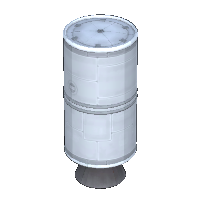Difference between revisions of "RT-10 "Hammer" Solid Fuel Booster"
(→Trivia: Very consistent part; I'm flying in 0.7.3 right now) |
(→Changes: Texture caption; 0.7.3 texture is very different) |
||
| Line 23: | Line 23: | ||
== Changes == | == Changes == | ||
| − | [[File:RT-10 Solid Fuel Booster.jpg|thumb|The texture | + | [[File:RT-10 Solid Fuel Booster.jpg|thumb|The texture from 0.8 to 0.18]] |
;{{Version|0.18|}} | ;{{Version|0.18|}} | ||
Revision as of 16:30, 28 February 2014
| RT-10 "Hammer" Solid Fuel Booster | ||
| Solid rocket booster by Found lying by the side of the road | ||
| Radial size | Small, Radial mounted | |
| Cost | (total) | 400.00 |
| (dry) | 175.00 | |
| Mass | (total) | 3.56 t |
| (dry) | 0.75 t | |
| Drag | 0.2-0.3 | |
| Max. Temp. | 2000 K | |
| Volume | ? | |
| Impact Tolerance | 7 m/s | |
| Research | | |
| Unlock cost | 1 200 | |
| Since version | 0.7.3 | |
| Part configuration | solidBoosterRT-10.cfg | |
| Solid rocket booster | ||
| Maximum thrust | (1 atm) | 197.90 kN |
| (vacuum) | 227.00 kN | |
| Isp | (1 atm) | 170 s |
| (vacuum) | 195 s | |
| Fuel consumption | 15.83
| |
| Thrust vectoring | No | |
| Fuel | 375.0 | |
| Burn time | (1 atm) | 20.7 s |
| (vacuum) | 23.7 s | |
| Testing Environments | ||
| On the surface | No | |
| In the ocean | No | |
| On the launchpad | Yes | |
| In the atmosphere | Yes | |
| Sub orbital | Yes | |
| In an orbit | Yes | |
| On an escape | No | |
| Docked | No | |
| Test by staging | Yes | |
| Manually testable | Yes | |
The RT-10 Solid Fuel Booster (also known as an SRB) is a solid rocket booster used to provide a short burst of additional thrust to a rocket. It comes as a single unit. The engine and fuel tank are one single part which means that it isn't possible increase the burn time for it by adding more fuel tanks.
Contents
Usage
RT-10's are one-shot rocket boosters often used to help get the massive bulk of a large multi-stage rocket off the ground. They burn at a constant thrust until they run out of fuel and then cease to work. RT-10 boosters can be stacked with axial decouplers or divided in different groups assigned to different stages, to allow for staggered firing and a longer total burn duration.
Another possible use is as a last stage for imparting high impulses to a very light payload: in this role, the high mass ratio of the RT-10s offsets the low vacuum specific impulse and the high thrust allows to complete a burn while in the vicinity of a planet, taking advantage of the Oberth effect. Since SRBs cannot be extinguished after ignition, though, this is difficult to put to fruition in KSP since the impulse cannot be easily changed.
RT-10 Solid Fuel Boosters are prone to overheating, especially when large numbers are clustered together. The main ways to overcome this are by using custom staging to stagger the firing, and attaching additional parts that are not SRBs (typically struts, control surfaces or winglets) to act as heat sinks. These 'heat sinks' can provide extra functionality by holding the boosters more securely to the main rocket as well help provide additional control.
Deliberately overheating the RT-10 — such as by stacking two and firing both at once — can let the booster function as an impromptu decoupler sometimes called “explosive decoupling”. This is useful if trying to maximize Science while at the lowest level of the technology tree, before proper decouplers are available.
Description
| “ | While considered by some to be little more than "a trash bin full o' boom", The RT-10 is used in many space programs, whenever the need to save cash is greater than the need to keep astronauts alive. Use with caution, though. Once lit, solid fuel motors cannot be put out until the fuel runs out. — Jebediah Kerman's Junkyard and Spaceship Parts Co. |
” |
Trivia
Between 0.7.3 and 0.15.2, the RT-10 was of limited use, mainly for providing extra challenge or silliness related to its high thrust to weight ratio. In rare cases it provided a small performance boost from overcoming the sticky pad bug or getting a rocket up to ideal speed.
In 0.16, the RT-10 had a specific impulse (or Isp) of 442.4 s, higher than any other solid or liquid fuel rocket, making a useful, if situational, choice (especially during launch). However, its increased mass in 0.17 reduced its Isp to 212.4 s. Other than these foibles, the RT-10 is possibly the most consistent original part, still looking and behaving much as it did in the earliest releases.
Changes
- Retextured
- Full mass increased from 1.8 to 3.5 tons; dry mass increased from 0.36 to 0.5 tons.
- Thrust increased from 130 to 250 (part rebalancing)
- New texture for the Solid Rocket Booster
- Initial Release
| ||||||||||||||||||||

